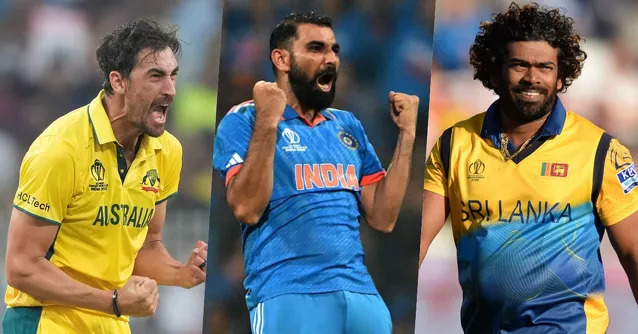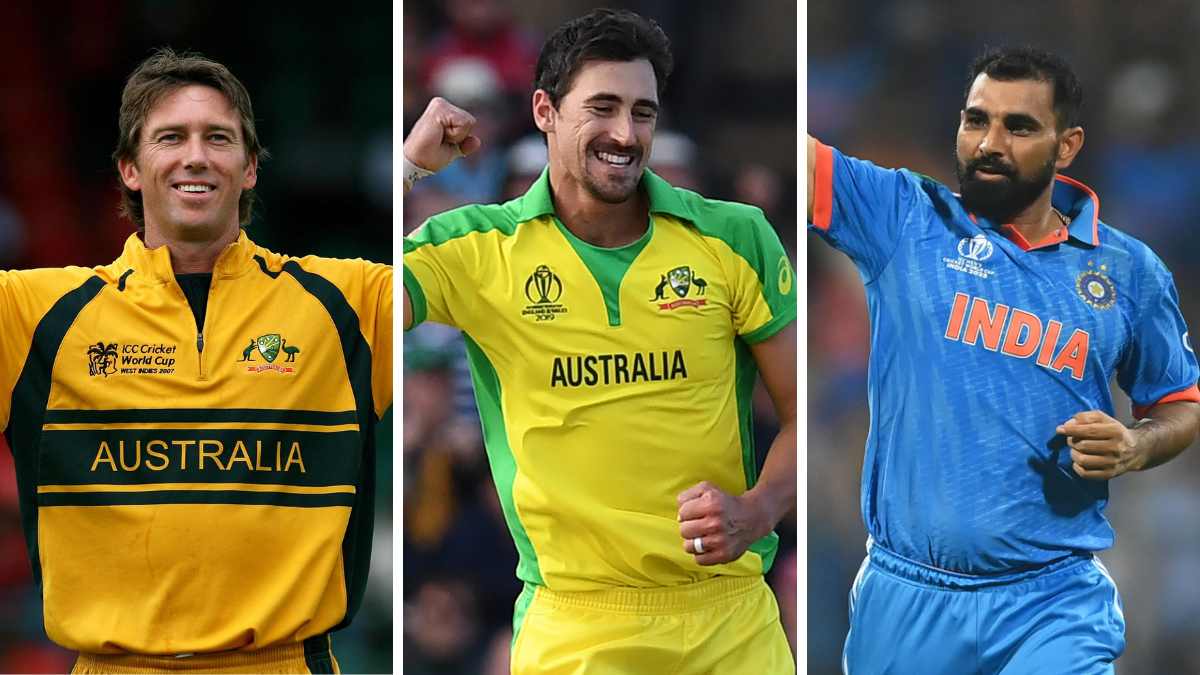The ODI Men’s World Cup is where bowlers have the chance to shine on the biggest stage, often turning games with their match-winning spells. Over the decades, the World Cup has seen bowlers break records and etch their names into cricketing history.
In this blog, we delve into the achievements of the bowlers who have taken the most wickets in ODI Men’s World Cup history, celebrating their consistency, skill, and match-winning performances.

1. Glenn McGrath (Australia) – 71 Wickets
Glenn McGrath, the epitome of accuracy and discipline, tops the list with 71 wickets in the ODI Men’s World Cup. Representing Australia across four editions (1996-2007), McGrath was a key player in Australia’s dominance, helping them secure three consecutive World Cup titles.
McGrath’s most memorable performance came against Namibia in the 2003 World Cup, where he claimed 7 wickets for just 15 runs—the best bowling figures in World Cup history. His ability to extract movement and consistently hit the right areas made him a nightmare for batsmen.
2. Muttiah Muralitharan (Sri Lanka) – 68 Wickets
The legendary spinner Muttiah Muralitharan ranks second with 68 wickets across five World Cups (1996-2011). Known for his deceptive spin and variation, Muralitharan played a crucial role in Sri Lanka’s 1996 World Cup-winning campaign.
Muralitharan’s ability to adapt to different conditions and exploit batsmen’s weaknesses was unparalleled. His spells in pressure situations often turned the tide in Sri Lanka’s favor, solidifying his status as one of the greatest bowlers in the ODI Men’s World Cup history.
Also Read:- India vs Australia Dream11 Prediction 3rd ODI
3. Lasith Malinga (Sri Lanka) – 56 Wickets
Famed for his slinging action and deadly yorkers, Lasith Malinga took 56 wickets in four World Cups (2007-2019). His knack for delivering in crunch situations made him one of the most feared bowlers of his era.
Malinga’s standout moment came in the 2007 World Cup, where he claimed four wickets in four consecutive deliveries against South Africa. This extraordinary feat remains one of the most iconic moments in World Cup history. His ability to bowl pinpoint yorkers and deceptive slower balls was instrumental in Sri Lanka’s success.
4. Wasim Akram (Pakistan) – 55 Wickets
Wasim Akram, often referred to as the “Sultan of Swing,” took 55 wickets across five World Cups (1987-2003). His mastery of swing bowling and ability to outthink batsmen made him a force to be reckoned with.
Akram’s defining performance came in the 1992 World Cup final, where his two magical deliveries to dismiss Allan Lamb and Chris Lewis turned the game in Pakistan’s favor. With his lethal reverse swing and control, Akram’s contributions were pivotal in Pakistan’s maiden World Cup triumph.
5. Mitchell Starc (Australia) – 49 Wickets
Mitchell Starc, Australia’s left-arm pace spearhead, has taken 49 wickets in just two World Cups (2015, 2019). His incredible performances earned him the Player of the Tournament award in the 2015 World Cup, where he was instrumental in Australia’s fifth title win.
Starc’s lethal inswinging yorkers and ability to deliver under pressure make him one of the most effective bowlers in modern World Cup history. His 6/28 against New Zealand in the 2015 group stage is remembered as one of the finest spells in World Cup cricket.
Honorable Mentions
While the top five have etched their names in World Cup folklore, several other bowlers have also made a mark:
- Chaminda Vaas (Sri Lanka) – 49 wickets
- Zaheer Khan (India) – 44 wickets
- Shaun Pollock (South Africa) – 31 wickets
Each of these players has had their moments of brilliance, contributing significantly to their teams’ World Cup campaigns.
What Makes a World Cup Bowler Legendary?
Being a successful bowler in the ODI Men’s World Cup requires a combination of skill, temperament, and adaptability. Here are some traits that define a legendary World Cup bowler:
- Consistency: Performing across multiple editions and delivering in high-stakes games.
- Impact: Taking crucial wickets in pressure situations, often changing the course of a match.
- Adaptability: Bowling effectively in different conditions and against top-class batsmen.
The bowlers listed above embody these traits, ensuring their legacy in the history of the tournament.
Conclusion
The ODI Men’s World Cup is a platform where bowlers can shine and lead their teams to glory. Legends like Glenn McGrath, Muttiah Muralitharan, and Lasith Malinga have set benchmarks that aspiring bowlers dream of surpassing. Their ability to perform under pressure and deliver match-winning spells remains an inspiration for cricketers worldwide.
As the cricketing world looks forward to future World Cups, it will be exciting to see which bowlers can rise to the occasion and etch their names among the greatest wicket-takers in ODI Men’s World Cup history.
Also Read:- India vs Australia Dream11 Prediction 3rd ODI

